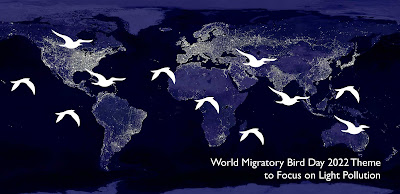This Saturday is the World Migratory Bird Count. Of course I will be doing it on Shaw Island along with Oblate Gigi and her busband Jim. In just a few days, goldfinches, purple finches, pinesiskins and house finches have appeared on my deck,en masse, facing Squaw Bay (recently renamed Reefnet Bay).
“Dim the Lights for Birds at Night!” has been selected as the official slogan of the 2022 global World Migratory Bird Day campaign.
Artificial
light impacts birds in the breeding and winter seasons, disrupting feeding and
other vital behaviors. In 2022, the impact of light pollution is the
focus of World Migratory Bird Day, an annual global campaign that celebrates
the migration of birds across countries and continents.
Artificial
light is increasing globally by at least 2 per cent per year and it is known to
adversely affect many bird species. Light pollution is a significant threat to
migratory birds, causing disorientation when they fly at night, leading to
collisions with buildings, interfering with their internal clocks, or
interfering with their ability to undertake long-distance migrations.
Biologists have
found that light pollution causes birds to begin nesting up to a month
earlier than normal in open environments such as grasslands and wetlands, and
18 days earlier in forested environments. The consequence could be a mismatch
in timing and hungry chicks may hatch before their food is available.
Birds that
migrate or hunt at night navigate by moonlight and starlight. Artificial
light can cause them to wander off course and toward the dangerous nighttime
landscapes of cities.
Studies
have estimated at least 100 million bird deaths are related to light pollution in cities
throughout the
Solutions to light pollution are readily available. For instance, more and more cities in the world are taking measures to dim building lights during migration phases in spring and autumn. Further information about the impacts of light pollution on migratory birds and steps one can take to address this issue will be made available on the WMBD website throughout the year.
There is a
group called International Dark-Sky Association
(IDA) which studies this problem-
not only in relation to birds but all wildlife. Many universities across the globe, as well as the Audubon Society, are studying this problem.
When one
looks at the above light-pollution map, it is easy to see that most of the
pollution comes from the East coast of
Someone recently
told me that during the first year of Covid isolation, when many businesses
were closed and lights turned off, they were able to see the night sky as they
had not in many years. Something to
ponder!


No comments:
Post a Comment